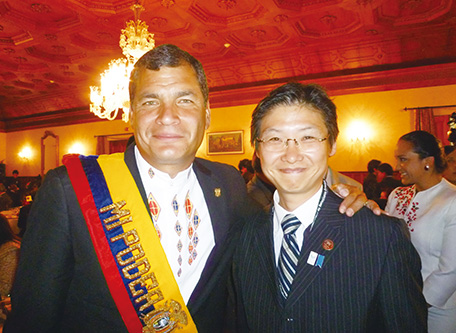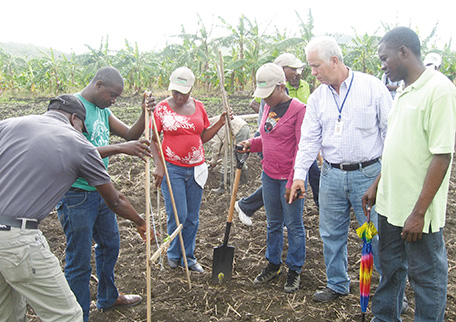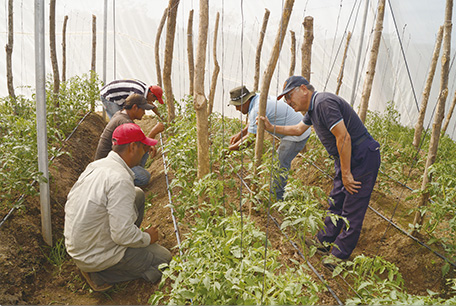Japan's Official Development Assistance White Paper 2013
6. Latin America and the Caribbean
With a population of 590 million and a regional gross production of $5.8 trillion, Latin America and the Caribbean is an enormous market. The region has been also increasing its presence in the international community through the consolidation of democracy and stable growth, and as a provider of steel, copper, silver, rare metals, crude oil, natural gas, biofuels, and other minerals and energy resources, as well as food resources. Although the average income level in the region is relatively high among ODA recipient countries, the region is also characterized by significant income disparities between the rich and the poor and a large number of people suffering from poverty. In addition, while the region is abundant with natural environments such as the Amazon Rainforest, it is also vulnerable to natural disasters such as earthquakes and hurricanes. Therefore, efforts to address the environment/climate change and disaster risk reduction are also important.
<Japan’s Efforts>
Latin American and Caribbean countries often suffer from natural disasters such as earthquakes, tsunamis, hurricanes, and volcano eruptions. It is important for Japan to support these countries with its knowledge and experience of disaster risk reduction. Japan provided emergency assistance and reconstruction and development support to Haiti, which suffered catastrophic damage from the huge earthquake with a magnitude of 7.1 in January 2010. It also provided assistance in anti-earthquake and anti-tsunami measures for countries bordering the Pacific Ocean. Furthermore, the “Project on Capacity Development for Disaster Risk Management in Central America “BOSAI”, which aims to share knowledge of disaster risk reduction and reduce disaster risks at the community level, has achieved significant results in the Latin American and Caribbean region.
In recent years, Latin America and the Caribbean have been attracting attention as a manufacturing base and market, and many Japanese companies are expanding their businesses to this region. In 2011, a training session on cardiac catheterization techniques* was held, and medical doctors from Mexico were invited. This training is expected to promote the dissemination of techniques unique to Japanese companies across the Latin American and Caribbean region. In addition, from the perspective of laying the foundation for the economic development of Latin American and the Caribbean countries, Japan has been actively implementing infrastructure development in the capital and regional areas.
Japan has been providing cooperation in a wide range of issues such as to address environmental issues, including scientific and technological research on climatic phenomenon, preservation of biodiversity, evaluation of carbon dynamics of Amazonian forests, and construction of waste disposal facilities. In the area of renewable energy, which has been receiving increasing attention in recent years, Japan provides support for introducing solar power generation in many countries, and also plans to support construction of geothermal power plants.
Japan also provides various kinds of cooperation for Latin American and the Caribbean countries in the healthcare area. In the Latin American and Caribbean region, Japan provided technical assistance to eradicate Chagas disease, a parasitic disease specific to the region, and has been contributing to the reduction of infection risk. In Paraguay and Peru, Japan has provided assistance in renovation of university hospitals, provision of medical equipment, and construction of rehabilitation centers for people with disabilities. Japan also provides a lot of cooperation in the sanitation area, such as the implementation of water and sewer systems for providing safe drinking water and recycling domestic water.
Assistance in the education area is extremely important for Latin American and Caribbean countries since poverty still remains high and the educational budget is not sufficient in these countries. Japan provides support for building educational facilities such as primary schools, as well as dispatching volunteers to improve the capacity of teachers. Such efforts are highly praised in these countries.
Japan’s long years of development cooperation have paid dividends in Brazil, Mexico, Chile, and Argentina. These four countries have achieved results in South-South Cooperation*. Japan signed partnership programs with these countries. For example, Japan works together with Brazil to provide agricultural development cooperation to Mozambique, as well as working with Argentina, the Dominican Republic, and other countries to provide assistance for the reconstruction process after the earthquake in Haiti.
Japan also cooperates with the Sistema de la Integración Centroamericana (SICA), the Caribbean Community (CARICOM), and other regional organizations to formulate wide-ranging projects in order to achieve more effective and efficient development cooperation related to development issues that are shared throughout Latin America and the Caribbean.
Under the public-private partnership (PPP), Japan cooperates in introducing the Japanese ISDB-T (Note 5) standards for terrestrial digital TV. By the end of September 2013, this system has been adopted by 12 Latin American countries. Japan supports these countries by transferring technology and training experts to enable smooth implementation of the system.
Moreover, to date, Japan has provided over $150 million
in assistance for reconstruction efforts in Haiti, which was hit by huge earthquakes in 2010. It will continue providing reconstruction support from a mid- to long-term perspective, with a focus on basic social services such as health, sanitation and education.
Furthermore, Japan provided emergency assistance in the area of water and sanitation, and nutrition to Haiti that was damaged by hurricanes which occurred in October 2012. In addition, Japan has provided assistance to Jamaica to help with the restoration of schools and hospitals.

At the hand-over ceremony of the classrooms construction project for the Manuel J. Calle School. (Photo: Milton Gualoto / Embassy of Japan in Ecuador)

President Correa of Ecuador and former Parliamentary Vice-Minister for Foreign Affairs Kenta Wakabayashi at the luncheon after the inauguration ceremony of the president in May 2013.
Glossary
- *Cardiac catheterization
- Specifically, this refers to transradial cardiac catheterization. This method involves inserting a catheter through a large blood vessel in the wrist in order to expand the blood vessels to the heart that have narrowed or become blocked.
- *South-South Cooperation
- Cooperation provided by advanced developing countries to other developing countries, using their own personnel and experiences in development. In most cases it is conducted among countries that have similar natural environments and cultural and economic circumstances, and are at a similar stage of development, etc. In addition, support by donors or international organizations for cooperation between such developing countries is referred to as “triangular cooperation.”
Note 5: ISDB-T: Integrated Services Digital Broadcasting-Terrestrial
●Haiti
Project on Technical Training in Agricultural Production System in Mountainous Areas to Technicians of the Republic of Haiti
Technical Cooperation (October 2010 - Ongoing)
The Dominican Republic and Haiti are located side by side, east and west of the island of Hispaniola in the Caribbean Sea. While the Dominican Republic is experiencing smooth economic growth, development in Haiti has stagnated due to ongoing political instability and frequent natural disasters. In response, Japan has connected these two countries through South-South Cooperation.
In Haiti, while more than 50% of the residents are engaged in agriculture, due to insufficient funds, poor logistical infrastructure for produce and underdeveloped agricultural technology, domestic agricultural production meets only 49% of the food demand of the population. Beginning in 2010, Japan has been facilitating training for Haitian agricultural consultants. Each year around 15 agricultural extension workers are invited to receive training on soil management, water management and cultivation techniques at the Instituto Superior de Agricultura in the Dominican Republic. Upon their return to Haiti, the participants who have completed the program provide support to small-scale farmers in mountainous regions by utilizing the skills acquired through the program. These skills include the introduction of organic fertilizers and soil and water management using used tires. Furthermore, the tutors of the institute and Japanese experts visit the agricultural communities in which the former students work in order to follow up on the program and to provide field training.
This project received the “Solution Award”, which recognizes outstanding South-South Cooperation initiatives, at the Global South-South Development Expo held in November 2012 in Vienna. Building on this achievement, Japan will proactively provide support for further South South Cooperation.
(As of August 2013)

Practical measurement training during the introductory training in 2013 (Photo: JICA)


A Senior Volunteer (vegetable growing) teaches small farmers pruning techniques to increase yield at CEDAF (center for family agriculture development) in Morazan department in Eastern El Salvador. (Photo: Ernesto Manzano / JICA El Salvador Office)

